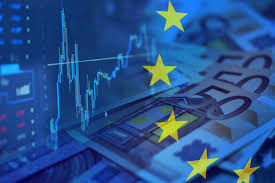The News
European Economic Forecast for October 2022
According to a survey published by S&P Global Market Intelligence on October 24, economic activity in the Eurozone continued to decline sharply in October, and Germany, the largest economy in the region, faced with recession risk.
According to a survey published by S&P Global Market Intelligence on October 24, economic activity in the Eurozone continued to decline sharply in October, and Germany, the largest economy in the region, faced with recession risk.
According to a survey published by S&P Global Market Intelligence on October 24, economic activity in the Eurozone continued to decline sharply in October, and Germany, the largest economy in the region, faced recession risk.
The preliminary purchasing managers' index (PMI) in the Eurozone fell to 47.1 in October from 48.1 in September, as inflation surged and energy prices were high.
PMI below 50 means economic activity is down.
The Eurozone economy may shrink in the fourth quarter of 2022, while the situation in Germany is worse, with PMI falling from 45.7 to 44.1. This is the lowest level since the first business closure in Germany, when the pandemic broke out.
Phil Smith, Deputy Director of economic research at S&P Global Market Intelligence, said the data was yet another sign of a recession in the region's largest economy.

Both the manufacturing and service sectors in Germany showed an increasing rate of decline, although there were still no job losses.
The second largest French economy in the European Union is stagnating, with PMI falling from 51.2 to 50.
Although France is less affected by rising inflation than other countries in Europe, rising prices still put pressure on consumers, leading to a sharp drop in factory orders.
S&P Global Market Intelligence Chief corporate economist Chris Williamson said the risk of a recession in the eurozone is becoming increasingly difficult to avoid. The energy crisis in this region is a major concern, hindering economic activity, especially in energy-intensive sectors.
Inflation in the Eurozone in September 2022 was near 10%, five times higher than the target of the European Central Bank.
Manufacturing activity across the eurozone continued to fall further in September while the cost-of-living crisis forced consumers to tighten their spending, rising energy prices hampered activity. manufacturing.
The combination of slowing manufacturing and growing inflationary pressures will add to concerns about the outlook for the Eurozone economy. Excluding the impact of the restrictions imposed during the COVID-19 pandemic, this is the first time that regional producers have seen demand and output decline of such magnitude. since the global financial crisis in early 2009.
Demand fell at the fastest rate since the global outbreak of COVID-19 in early 2020, the number of pending orders decreased, the number of unsold finished goods kept in warehouses increased as factories increase selling prices to compensate for increased costs. This means that optimism is narrowing and the futures output index has also dropped rapidly, from 52.7 points to 45.3 points, the lowest since May 2020.
Rising costs combined with falling demand also led to lower corporate confidence in September, with companies reducing input purchases and job growth as they prepare for a tough winter. towel in front of you.
The reason Europe's inflation continues to escalate is because energy costs are now 40.8% higher than they were in the same month last year - while prices for food, alcohol and tobacco are said to have risen by 11.8%. compared with the same period last year.
The Baltic countries remained the hardest hit with inflation rates of 24.2%, 22.5% and 22.4% respectively in Estonia, Lithuania and Latvia.
The region's lowest inflation rate is 6.2% in France with Malta and Finland at 7.3% and 8.4% respectively.
In the 19 Eurozone countries, 10 recorded overall double-digit inflation, including the largest economy, Germany, at 10.9%. That is the highest inflation rate Germany has seen since 1951.
Some European economic forecasts by organizations:
UNDESA forecasts Europe's GDP to grow by 2.5% in 2022, down 0.2% from its June 2022 forecast. Rising food and energy prices are hitting households hard, sending consumer confidence to a record low in July, even lower than it was at the start of the pandemic. A strong recovery in the labor market and low unemployment are likely to help boost domestic demand. The European Central Bank (ECB) raised its base rate for the first time in more than a decade in July 2022, ending an eight-year period of negative interest rates.
According to the Economic Development Outlook update report released on September 21, 2022, ADB revised down its growth forecast for the euro area in 2022 to 2.5%, down 0.8 percentage points from with the forecast made in April 2022. The euro area inflation forecast stands at 7.9% in 2022.
The OECD revised up its forecast for GDP growth in the euro area, from 2.6% in the June 2022 forecast to 3.1%.
According to the latest IMF report, GDP growth in the euro area is forecast to reach 2.6% in 2022, adjusted down by 0.2 percentage points compared to the forecast made in April 2022.
The IMF's Regional Economic Outlook for Europe comes as countries here are grappling with escalating inflation and a deepening energy crisis that has reduced the purchasing power of households. family, while production costs increase.
The IMF assessed that the new support packages offered by the governments only "partially offset" these tensions.
The conflict in some areas has lasted for the past 8 months, causing inflation as well as energy prices to skyrocket, forcing the European Central Bank (ECB) to raise interest rates to cool down the economy in the face of a recession. .
The IMF report assessed that: "Europe's economic outlook becomes much darker, as growth slows and inflation continues to rise".
According to IMF forecasts, Germany and Italy will fall into recession next year, thereby becoming the first developed economies to grow negative due to the impact of the conflict in some areas.
The IMF emphasized: "While Europe has been trying to get out of the Covid-19 pandemic since the end of last year, the tension in Ukraine has completely changed this picture."
Growth in Europe's advanced economies will slow markedly to 0.6% in 2023. Meanwhile, in the region's emerging economies, excluding the surrounding countries involved and Turkey, growth will also slow to 1.7%, while the damage in conflict countries will be huge.
According to the IMF, the biggest immediate risk is that energy supply disruptions during the cold winter could lead to gas shortages, food shortages and deeper economic trauma.
The IMF forecasts that inflation will persist and social tensions may worsen due to the rising cost of living. Accordingly, in the current situation, central banks should continue to raise policy rates, especially in advanced economies.
Policymakers need to be "on track" to both succeed in their efforts to combat inflation and support vulnerable households and businesses through the energy crisis.



